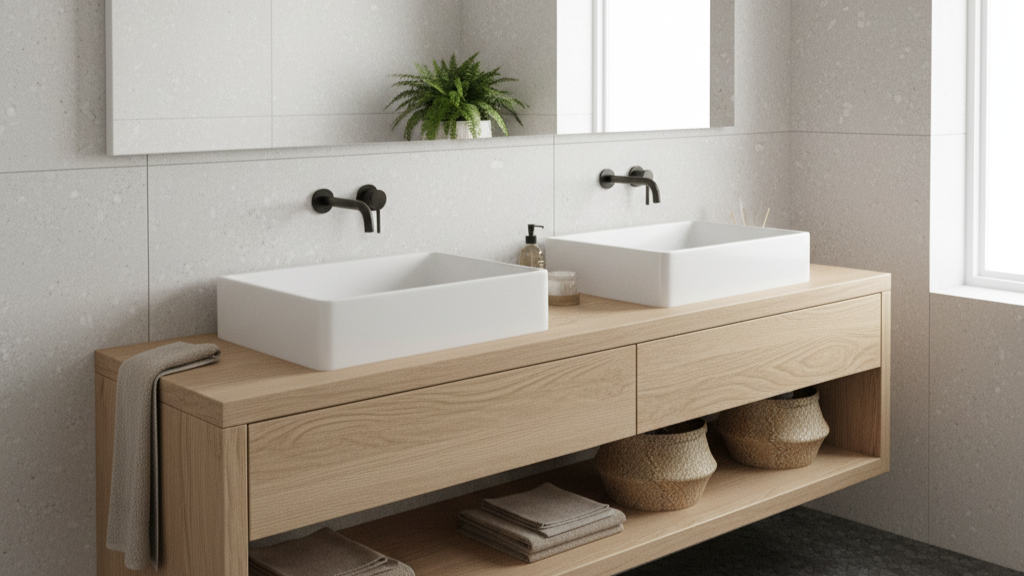Do You Really Need a Double Sink in Your Bathroom?
A double sink, or dual vanity, is a popular feature in modern bathrooms, offering two basins for shared use. However, is it a need for your area or a waste of money? Space, lifestyle, and budget all play a role in determining whether a double sink is right for you, as bathroom design trends in 2025 will focus on sustainability and functionality. This guide helps you determine whether a double sink is appropriate for your clean, eco-friendly bathroom by examining the benefits, drawbacks, and important factors.
What Is a Double Sink?
A double sink is a bathroom vanity with two basins, typically mounted on a single countertop, each with its own faucet and drain. Available in materials like quartz, porcelain, or bamboo, they range from 48 to 72 inches wide, designed for shared use by couples, families, or busy households. They enhance functionality but require more space and plumbing than single sinks.
Pros of a Double Sink
Shared Space: Ideal for couples or families, double sinks allow two people to use the bathroom simultaneously, reducing morning rush conflicts.
Increased Storage: Larger vanities often include more drawers or cabinets, perfect for storing eco-friendly products.
Luxury Aesthetic: Adds a spa-like, upscale look.
Higher Resale Value: Appeals to homebuyers seeking modern, functional bathrooms.
Personalized Space: Each user gets their own basin and counter area, reducing clutter and enhancing hygiene.
Cons of a Double Sink
Space Requirements: Needs at least 48 inches of width, unsuitable for small bathrooms.
Higher Cost: Installation, materials (e.g., quartz from “What Is the Ideal Type of Countertop for Your Bathroom?”), and plumbing cost 20–50% more than single sinks, averaging $1,500–$4,000.
Increased Water Usage: Two faucets may lead to higher water consumption unless using low-flow models.
Maintenance: More surfaces to clean.
Plumbing Complexity: May require additional piping.
Key Considerations
Bathroom Size: Measure your space. Double sinks need 48–72 inches of width and adequate floor space to avoid a cramped feel. Small bathrooms may benefit more from a single sink with a hair catcher.
Household Needs: Couples, roommates, or families with multiple users benefit most. Single users or small households may find a single sink sufficient.
Water Efficiency: Choose low-flow faucets (1.2–1.5 GPM) to minimize water waste. WaterSense-certified faucets save up to 20% water, per EPA estimates.
Material Choice: Opt for sustainable materials like bamboo or recycled quartz to reduce environmental impact.
Budget: Factor in costs for the vanity, faucets, plumbing, and installation. If budget is tight, a single sink with eco-friendly upgrades may be better.
Ventilation: Ensure a smart exhaust fan to reduce humidity and prevent mold, especially with more water usage.
Do You Need a Double Sink?
Best For:
Large Bathrooms: Spacious layouts with room for 48+ inches of vanity space.
Busy Households: Couples or families needing simultaneous sink access.
Luxury Upgrades: Those aiming for a spa-like aesthetic with added storage.
Not Ideal For:
Small Bathrooms: Limited space makes single sinks more practical.
Solo Users: Single households don’t need dual basins.
Tight Budgets: Higher costs outweigh benefits for cost-conscious upgrades.
Maintenance Tips
Clean Regularly: Use vinegar or eco-scrubs to prevent soap scum.
Check for Leaks: Inspect faucets and drains to avoid water waste.
Ventilate: Run a smart exhaust fan for 20–30 minutes to reduce moisture.
Use Eco-Accessories: Pair with a bamboo soap dish or organic cotton towel for sustainability.
Make the Right Choice for Your Bathroom
A double sink adds functionality and luxury for busy households but may be overkill for small spaces or solo users. Weigh space, budget, and eco-goals to decide if it’s worth the investment. For smaller bathrooms, a single sink with sustainable upgrades like low-flow faucets can achieve a hygienic, eco-friendly space without the extra cost.
